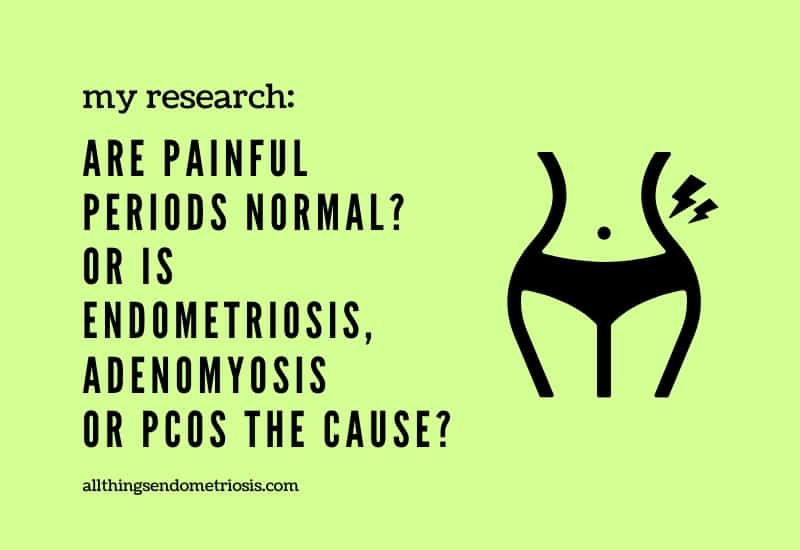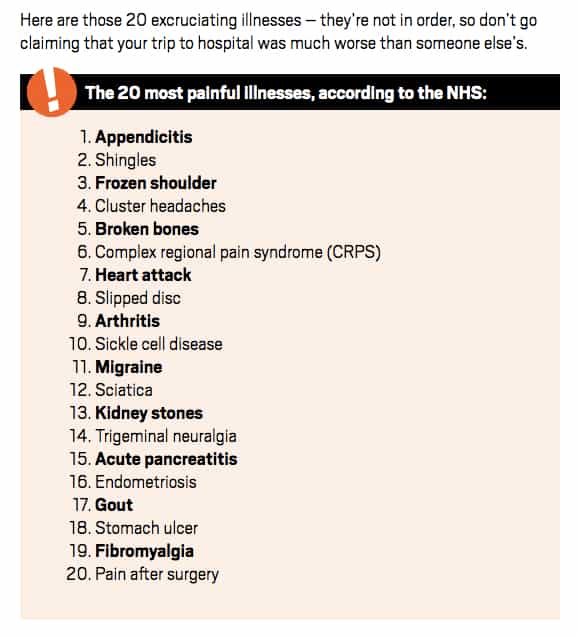
All too often women’s pains, especially period (menstrual) pains are dismissed as being ‘normal’, but are they really? Is there a ‘pain bias’ at play? I explore these questions today…
Let’s get down to the basics first…
What are Periods?
During the month, the lining of the uterus starts to thicken with blood and mucosal tissue, which then needs to shed every 21 to 31 days. It does so by releasing this over the course of five to seven days through the vagina.
This is called a period.
Now…
Why do Women Have Periods?
The lining of the uterus thickens in preparation of creating a conducive environment for a fertilised egg (pregnancy).
When pregnancy doesn’t occur, the body needs to release this lining in order to start all over again, which is why the period happens.
A few days after a period is over, ovulation occurs in which an egg is released out of the body through the vagina.
FYI – periods are also known as menses, menstruation, monthly, chums and various other names all depending on where you grow up or even what your mum calls it.
Is Period Pain Normal?
A small amount of cramping up and pain in the lower abdomen that doesn’t hinder your everyday life is supposed to be normal.
You may even experience constipation, tiredness, moodiness and/or acne.
What isn’t normal is when the cramping and pain hinders your life. This isn’t meant to be pain that debilitates you causing you to remain curled up in bed for hours and days not wanting to move.
You’re not supposed to hurt so much that it leaves you screaming and crying.
You’re not supposed to hurt so much that you throw up and/or have diarrhea.
You’re not supposed to hurt so much that it causes depression.
In fact you’re not meant to feel these cramps when you’re not on your period.
Instead, how it’s supposed to be is, yes you go through some cramping and discomfort, maybe for a day during which a hot water bottle and a pain killer should help you through – but not too much more than that.
So to answer the question, a painful day maybe normal, but painful periods before it and during it are not normal.
Read Here For:
- Relation Between Endometriosis / EDS and Chronic Fatigue
- Tips: Chronic Illness and Relationships
- Tips: Dating Someone with a Chronic Illness (like Endometriosis)
Pain Bias
I sometimes wonder why this is ever a point of discussion – why should pain be normal.
The issue lies in ‘pain bias’.
Women are known to not be taken seriously by their doctors.
Gabrielle Jackson, who was diagnosed with endometriosis wrote this in the Irish Times:
“…women wait longer for pain medication than men, wait longer to be diagnosed with cancer, are more likely to have their physical symptoms ascribed to mental health issues, are more likely to have their heart disease misdiagnosed or to become disabled after a stroke, and are more likely to suffer illnesses ignored or denied by the medical profession.”
Here’s another kicker…
“Most shockingly of all, many women are living in constant pain and don’t know that it’s not normal; they don’t appreciate that they don’t have to live like that at all. Why don’t doctors trust us? The answer turns out to be quite simple. They don’t really know much about us.”
I feel in these 24 years of visiting doctors, I too believe they don’t really know much about us.
Women are often equated with their emotions believing they’re being hysterical for no real reason. Their cries are often ignored as ‘just pain’.
I came across this interesting piece about a woman’s experience in the ER, where her abdomen pain required emergency surgery, but had to wait 14.5 hours to be taken seriously – all the while being told “You’re just feeling a little pain, honey.” …until her scan told them otherwise.
This discrepancy in treatment lead Abby Norman, diagnosed with endometriosis to write a book titled ‘Ask Me About My Uterus: A Quest to Make Doctors Believe in Women’s Pains’.
Now why am I pointing out all of this?
It’s simple, if you have pain, it isn’t normal. Whether it’s period pain or your neck hurting or anything… in fact, I had severe neck and back pain – an orthopaedic told me it was just stress and that I should go on holiday.
He didn’t investigate at all.
I got to the point where I would sneeze and my neck would go into horrible spasms.
Later, a MRI showed two slip-discs in my neck and one in my lower back.
No amount of holidays and stress free living could’ve helped that – what helped was regular physiotherapy sessions, which I followed through dedicatedly and managed to get better from it.
Although I was diagnosed with suspected endometriosis and PCOS quite early on, I still faced doctors who dismissed that opinion.
Endometriosis is actually diagnosed only through a laparoscopy and I was only 11 so the doctors, looking at the signs treated me for endometriosis.
The pain started getting unbearable so at age 18, I had a diagnostic laparoscopy in which ablation of endometriosis was done, thus confirming the diagnosis.
Relevant Read:
It was during this time that I learnt that you need to be persistent and be factual.
I realised very early on that adding too much emotion to my pain descriptions never helped my cause – I had to give percentages and specify areas of pain – I even kept a pain chart.
This approach was working for me – in fact if you wish to read how best to tackle doctors and be better prepared, you can read my… Ultimate Guide: How to Prepare for a Doctor’s Appointment for Endometriosis
Just in case you wish to watch a video version of this post then you can here on my YouTube channel or just scroll down to continue reading…
What Causes Painful Periods
The following is a list of just some of the medical conditions that contribute to or cause painful periods.
1. Polycystic Ovarian Syndrome (PCOS)
Affecting 1 in 10 women, PCOS is a condition caused by:
– the imbalance of the male hormone, which can be seen to be higher than normal – this is usually determined through a blood test.
– cysts in the ovaries – these are small fluid filled sacs and because there are many of them, therefore the term ‘polycystic’
These cysts are usually found during an ultrasound of the area.
– irregular periods – you can understand whether you’re facing this by charting your periods cycle. How many days you bleed and how often.
Some underrated symptoms are acne, facial/body hair, heavy bleeding (menorrhagia) and painful periods (dysmenorrhea).
Relevant Read:
2. Endometriosis
En-doe-mee-tree-O-sis …yep that’s how it’s pronounced and for some random reason, I’ve loved emphasising the ‘O’ there!
Okay now, what’s endometriosis?
Endometriosis is when tissue lining similar to that of the uterus is found growing outside of it.
Because this tissue is similar to that of the uterus lining, every month, the endometriosis thinks it’s having a period too, but it has nowhere to go so the blood gets trapped.
The endometriosis tends to multiply and find its way to other organs which it tends to get stuck to such as the bowel region, ovaries, bladder – it’s even known to travel to the lungs and in very rare cases, it gets to the brain too.
Endometriosis pain levels increase during the time of a period quite logically as it wishes to shed the blood it holds on to causing immensely painful cramping.
Then there is additional pain as it aggravates organs in the region too.
Heavy bleeding (menorrhagia) is also associated with endometriosis.
Therefore, you may or may not be on your period, but endometriosis is such a troublesome disease that it can cause debilitating pain no matter what.
In fact, the endometriosis features in NHS’s list – ’20 Most Painful Illnesses’

Another reason why this pain shouldn’t be dismissed as regular menstrual or pre-menstrual pain.
3. Adenomyosis
Adenomyosis is when the inner lining of the uterus breaks the muscle wall of the uterus.
Painful periods, heavy bleeding, cramping and extreme bloating are all symptoms of this condition.
The only known cure for this is a hysterectomy.
Relevant Read:
4. Uterine Fibroids
These are muscular tumours that grow in the wall of the uterus causing painful periods, heavy bleeding, constipation, trouble peeing, painful sex, miscarriages and infertility.
5. Pelvic Inflammatory Disease (PID)
PID is when the bacteria of a sexually transmitted disease spreads from the vagina to the cervix, uterus, fallopian tubes and the ovaries.
This infection tends to cause pelvic pain even when you’re not on your period.
Along with pain, you can expect to experience painful urination, bleeding during intercourse, painful intercourse, mid-cycle bleeding and even fever.
Relevant Read:
6. Perimenopause
This is the phase where your body starts to transit towards menopause. This phase can last anywhere from from four to eight years.
During this time you can experience an array of symptoms from irregular periods, heavy bleeding, more cramping than usual, hot flushes and abdominal pain.
“Some women naturally have more painful cramps than others. Conditions like endometriosis, uterine fibroids, and pelvic inflammatory disease can also cause painful cramping during your reproductive years.”
7. Ehlers-Danlos Syndrome (EDS)
EDS is connective tissue disorder classified into 13 subtypes.
Its symptoms include hypermobility of joints, stretchy skin, tissue fragility, joint pain, muscle pain, slow healing, osteoarthritis, dislocations amongst other things.
There was a study done that explained:
“Heavy menstrual bleeding was reported by 32.9% survey participants. Gynecologic pain reported included dysmenorrhea by 92.5% and dyspareunia by 77.0%.”
Relevant Read:
8. Flu/Fever
Something even as simple as having fever or the flu will most likely increase pain during menstruation and it tends to get worse if you have any one of the conditions mentioned above – or even a medical condition I may have missed out on.
When your body’s immunity is low you become more susceptible to pain which also includes this time of menstruation.
It’s tough to know and mention all the medical conditions that contribute or cause painful periods – I’ve tried to give you this basic list of eight possibilities to help you understand one important point…
Painful periods are NOT normal.
You do not have endure such pain – there must be a cause behind it.
Speak to your doctor about this and if he/she don’t listen then sadly, you’ll have to keep looking for one that will believe you.
If you are looking for natural pain relieving options, then here’s a link to the remedies I try as I fight my battle with endometriosis, adenomyosis, PCOS, Ehlers-Danlos syndrome and MCAS.
If you like what I write and wish to support me further then do check out my social media and follow me on Instagram, Twitter, Facebook, Pinterest or YouTube.
Thank you for reading and supporting.
~~~~~~~~~
Disclaimer: I am not a medical professional. I am a patient and have created this platform to share my experiences. This is all purely informative and in no way am I providing medical advice. Please consult a medical professional.


It must have been so frustrating to have your pain dismissed for so many years. I’ve experienced that on a few occasions but, likely due to the fact that I’m male, my pain has generally been taken seriously. I wish that doctors were better trained to understand their own unconscious biases or we discovered an objective way to measure pain levels. Thank you for sharing your experience on a topic that many consider as ‘taboo’
Hi Jason,
I agree with you there – I wish there was a way to measure pain levels, but until then doctors do need to start looking at patients with their symptoms rather than judging them by their gender. Luckily now I have a set of doctors who treat my condition rather than be fixated on my gender.
Thank you for reaching out. 🙂
I had no idea EDS could cause that. I was diagnosed with Joint Hypermobility syndrome at 16 before it was classified lately as EDS hypermobility and my periods were Brutally painful and long with heavy bleeding. I thought… just normal for me. But I was called lazy for not ‘dealing with normal pain’ like that as a teen… I couldn’t function with it.
O yes Nikki, EDS & JHS are definite contributors to period pain. In fact Endometriosis is a comorbidity of EDS. I wrote a piece in which I’m looking to see if there is a connection between EDS and Endo – here’s the link in case you’re interested… //allthingsendometriosis.com/my-experience-connecting-endometriosis-and-ehlers-danlos-syndrome/
And no you’re not lazy – none of us are and heavy bleeding and pain is never normal. I just find it so sad when it’s okay for us to believe that.
Thank you for sharing this though… a big hug to you.
Then you’re taken “seriously” diagnosed with fibromyalgia and every pain ever gets thrown into that and ignored again!
Great article and explanation 🙂
Thank you Melissa…
That’s so true – suddenly everything gets thrown under one condition. My doctor was telling me the other day how many doctors are just not willing to investigate – they’ve no curious bone in their body wanting to really understand their patients.